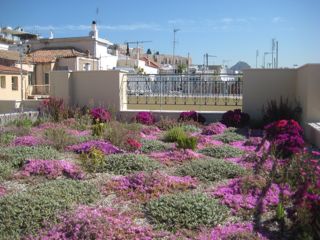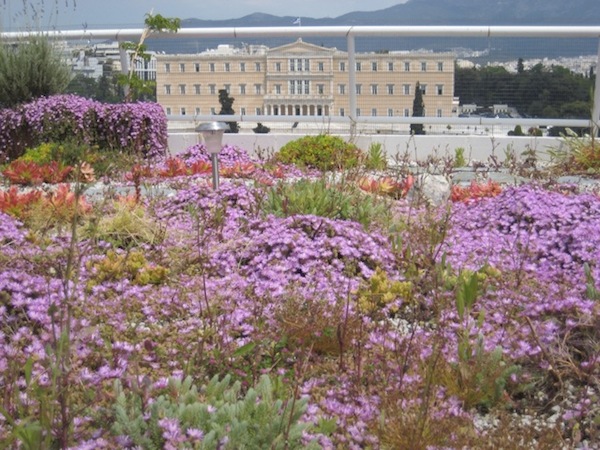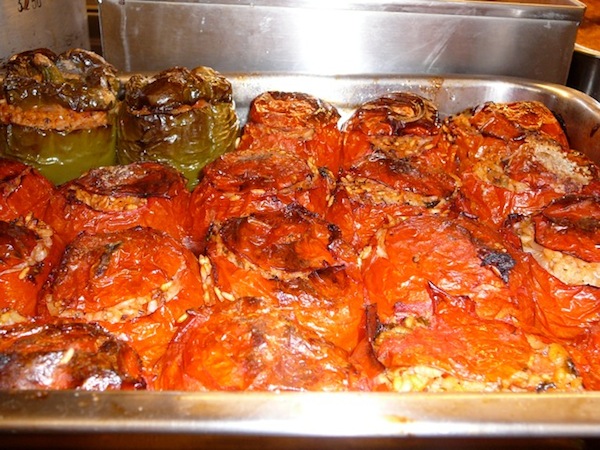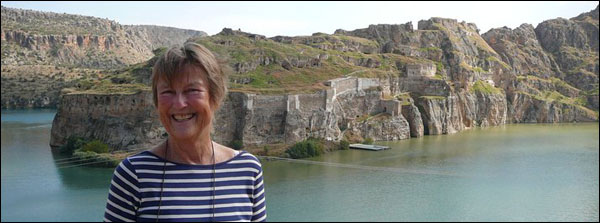Riots And Revolutions In Athens: Greening Greece’s Rooftops
“Andrew Michael Clements doesn’t look like a radical. He has no tattoos nor piercings; black leather jacket nor fiery eyes. But the 40-something Englishman/naturalized Greek does have a plan to revolutionize his adopted city. Passionate about this country and its biodiversity, he has invented several approaches for transforming Greece’s flat roofs into climate-altering ecosystems. He has a vision of Athens camouflaged under an endless, natural, Greek hillside meadow, flecked with the spectacular colors of tiger swallowtail butterflies and lady bugs, robins and yellowhammers, perfumed by the subtle aromas of sage and thyme.” Diana Farr Louis
Eating Well Is The Best Revenge
by Diana Farr Louis
ATHENS Greece—(Weekly Hubris)—7/2/2012—“The most revolutionary thing you can do on this earth is grow a riot of color in an urban jungle.”
Andrew Michael Clements doesn’t look like a radical. He has no tattoos nor piercings; black leather jacket nor fiery eyes. But the 40-something Englishman/naturalized Greek does have a plan to revolutionize his adopted city. Passionate about this country and its biodiversity, he has invented several approaches for transforming Greece’s flat roofs into climate-altering ecosystems. He has a vision of Athens camouflaged under an endless, natural Greek hillside meadow, flecked with the spectacular colors of tiger swallowtail butterflies and lady bugs, robins and yellowhammers, perfumed by the subtle aromas of sage and thyme.
His Athens is a city that has freed itself from ever-increasing energy costs, and escaped the “vicious circle of using air conditioning to cool our apartments, while actually raising the temperatures outside, in favor of a virtuous circle in which air conditioners are unnecessary.”
Green roofs have been around since the Hanging Gardens of Babylon but, in the modern era, they were made only briefly fashionable by Le Corbusier and the Bauhaus movement in Germany, Austria, and Switzerland. In the 60s, interest revived in those same countries, and now more than 10 percent of all flat roofs in Germany—10 million+ square meters—are planted.
Ironically, though, in their modern form, they were unknown in Greece, which has a far greater need for natural cooling, when Clements began investigating their application and later founded his company, Oikosteges, or Ecoroofs (http://www.flickr.com/photos/xarakap/4037247217/).
His search started in 2000, when he bought a 120-year-old house in the mountains above Corinth, and decided it should have a green roof to insulate it from the fierce winter cold. He traveled to Central Europe and met all the “movers and shakers of the industry,” none of whom was interested in starting up something in “such a small market.” He then returned, even more determined to make it happen, and called upon friends—engineers, landscape architects, botanists, and architects—and expert members of the Mediterranean Garden Society for help.
“I was a financial consultant when I discovered Greece on holiday 25 years ago. I fell in love instantly and irrevocably: first with a girl, then with the country, and went back to The City, packed my bag, and moved here. Until I founded Oikosteges, I taught English in Athens and even started my own language school, but I’d always loved nature. I was born in Rugby and grew up in the heart of rural England during the reign of Margaret Thatcher. Although my family, friends, and British culture as a whole were all business- and sport-oriented, I was more interested in growing things and had my own marrow patch by the age of eight.”
As we sit outside a Starbucks in the middle of the smart district of Kolonaki in central Athens, fittingly on Earth Day, Andrew’s grey eyes shine with enthusiasm as he takes me on a whirlwind inventory of Greece’s mineral and botanical wealth.
“The truth is that this country is paradise. You know the old story about the Creation? When God was handing out resources to all the nations, He got to the end of the list and realized that He’d forgotten Greece. ‘How could I do that? The country will be giving so much to civilization, I’ll reward it with a piece of Heaven.’ And that is why Greece has everything, just in small amounts.
“We have countless ecosystems and microclimates here—deserts, Alpine mountains, Siberian tundra (in northern Macedonia), even subtropical areas—and one-third of all the plants found in the whole of Europe. Added to this biodiversity is amazing mineral wealth, from bauxite to pumice, uranium to gold.
“And on my search for solutions to my green roof problem, I explored them all. In fact, everywhere I went, I carefully lifted out a slice of ecosystem, brought it home, and naïvely laid it with other previous finds on the school roof. This did not work. Conversations with ecosystem specialists led to the realization that you can’t simply transplant an ecosystem: you have to provide the initial conditions for one to develop in situ. Find out how it evolved and then mimic the start-essentials, drainage, moisture storage, mix of earth, the right species . . . .
“That was a tall order. Our first priority was of course safety. We had to devise the lightest material possible and we have—it’s only 20 kg/ sq m, and that’s the lightest surface that exists. We also had to make it waterproof—no leakage allowed—resistant to seismic tremors, able to survive the summer meltemia (north winds) of 60 km/hour at 40°C, which are the equivalent of a monumental hairdryer, not to mention the monsoon type rains we get in winter when 15 mm can fall in 15 minutes after six months of drought.
“But we solved all these problems and only eight painstaking years after our odyssey adventure began, we made it to our Ithaca: The Ministry of Finance on Syntagma Square commissioned us to plant their roof. Now, that project is one of the flagship examples for the industry round the world, along with such notable pioneering works as the Chicago Town Hall and the California Academy of Sciences. It has already saved the Ministry thousands every year in air conditioning and heating bills. As a side benefit, the roof not only repels pigeons, it has actually attracted butterflies and song birds back to the city center.

Oikosteges offers different installation methods depending on whether the client is building from scratch or wants to plant an existing roof. In the latter case, they use portable “cushions” made of a weatherproof geotextile which is filled with a rich mix of Greek minerals. You slit them open, stick in a plant—a hardy herb or low shrub—and that plant will never need fertiliser. From the outset, the system barely needs watering, and even less so after the plants are established, since the substrate in which they grow has the capacity to generate dew.
“It’s a no-brainer that Greece could save millions in energy costs if green roofs became a policy. At the price of 100 euros per square meter, we could cover all the roofs of Athens for less than a billion. That might sound like a lot but, if we were to divert a fraction of the funds we use for buying military equipment, it would be easily affordable. Unfortunately, supporting our allies’ defense industry is locked into Greece’s bailout program . . . .

“But, speaking of The Crisis, we’ve adapted the Greek way of approaching life siga-siga, or slowly-slowly. Just as the countryside is full of buildings that are being built in stages, a person can install the cushions a few at a time. Even that will be beneficial. For example, a frail old lady in central Athens who hates air conditioning had us create a roof for her of strawberry plants. She can’t negotiate the steep stairs to see them but we harvested a big bowl for her and she has turned off her a/c.
Oikosteges has won lots of support in Greece—its Facebook page, Green Roofs Greece, has 22,000 members. And Clements is working with other like-minded individuals, including Spyros Kouvelis, former Junior Minister for Foreign Affairs, to develop a campaign, “Greeks Can!”, to promote Greece as it really is, not what popular opinion thinks it is.
“I believe humanity is at a crossroads. I’m not an ecologist, and I don’t believe the world needs saving; it’s been through much worse than we could ever throw at it. But we do need to save ourselves, and the only thing that can save humanity is nature. Nature has a 15-billion-year-old R&D department that we can learn from. The greenest energy is the non-use of energy. By growing things and growing them in unconventional places, we can reverse some of the damage we’ve done.”
After having completed countless projects of varying sizes in Greece, Oikosteges is now ready to export its knowhow to other countries with similar climates. They are already working with other Mediterranean countries and hope to expand into the Middle East and even the United States.
Oikosteges is quietly transforming Greece’s bare concrete slab roofs into bio-diverse, abundant, natural ecosystems, one square meter at a time. The process is well under way and gaining momentum. The Oikosteges story can inspire and act as a model for cities worldwide. Roof greening is one way that we can restore our beautiful planet to its original pristine beauty. Clements modifies Gil Scott-Heron’s quote to, “The Revolution isn’t being televised,” but, he says, it IS happening. And it is happening in Greece, the place where so many important contributions to humanity originated.
For further information and lots of photographs, go to www.oikosteges.gr (Greek); and www.vveco.eu (English). You can contact Andrew Clements at info@oikosteges.gr
![]()

Recipe
Stuffed Tomatoes, Corfu-Style
As a true Hellenophile, Andrew is very partial to Greek food, especially when it includes the flavors of the wonderful herbs so plentiful in our countryside and which adapt so well to city rooftops. Here is my version of Stuffed Tomatoes Corfu-Style, slightly revised from the original, which appears in Prospero’s Kitchen, Island Cooking of Greece, just published by IB Tauris/Macmillan.
You can be as liberal with the herbs as you want; these amounts are just guides.
12 large firm tomatoes
sprinklings of salt and sugar
2 lb additional tomatoes, skinned, halved, seeded, and grated
1 large onion, peeled and chopped
2 small green peppers, seeded and finely chopped
2-3 cloves garlic, finely chopped
olive oil, at least ½ cup
3 tablespoons chopped parsley
2 tablespoons chopped basil
2 tablespoons fresh mint or 1 tbsp dried, finely chopped
2 tablespoons fennel tips, finely chopped, or
1 tablespoon thyme or oregano, crumbled
pinch of ground cinnamon
pinch of ground cloves
cayenne pepper to taste
1 tablespoon tomato paste
8 tablespoons short grain rice
Preheat the oven to 375° F/180°C. Slice the caps off the tomatoes and reserve. Scoop out the insides, taking care not to pierce the skins. Sprinkle the cavities with a little salt and even less sugar (to bring out their sweetness). Chop the insides and place them in a large bowl with the grated tomatoes.
Sauté the chopped onions, peppers, and garlic in half the olive oil over medium heat. When they are soft and about to brown, add the herbs and spices, stir thoroughly, and then add half the chopped/grated tomatoes and tomato paste. Cook, covered, for a few minutes to make the tomatoes exude their liquid faster, then add the rice and simmer until most of the liquid has been absorbed.
Remove from the heat and when the mixture has cooled a bit, spoon some into each of the tomato cases, to about ¾ full. Put the filled tomatoes into a roasting pan and replace their caps. Pour the rest of the tomato puree, mixed with the remaining oil, salt, pepper, and a little more sugar, over the tomatoes. Bake for about 1 hour.
Equally good served hot or at room temperature. Will feed between 6 to 12 people, depending on what else you’re having. Greeks love to put potato wedges between the tomatoes.

